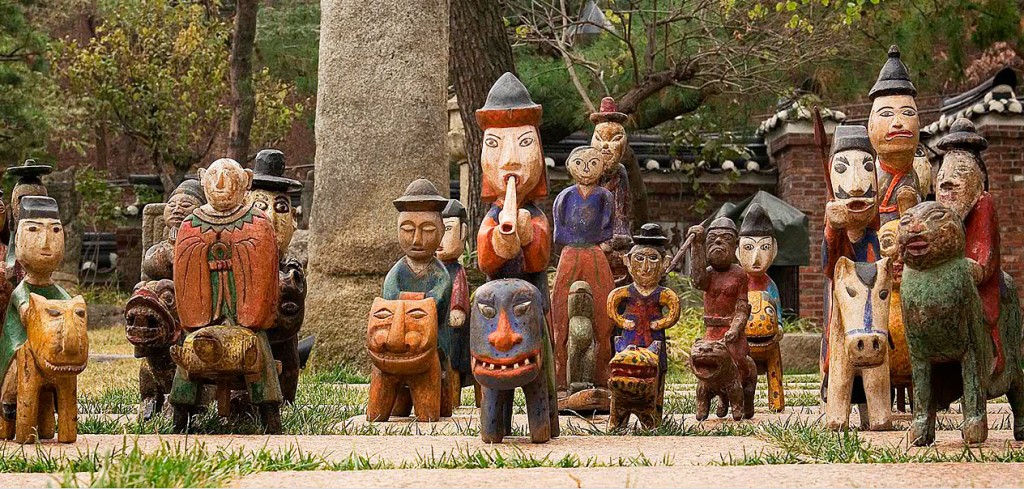

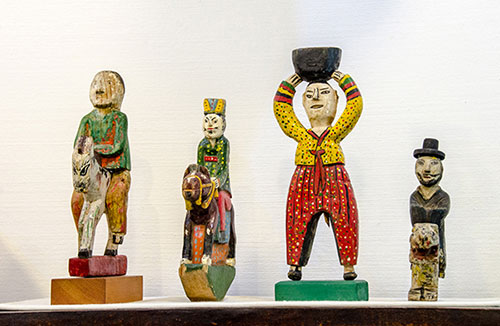 On one of my first trips to Korea, I came across some carved and painted figures in an antique shop in Insadong that I found to be pretty wonderful. I didn’t know what they were and the shop owner spoke no English so I didn’t ask. But it didn’t matter. They were charming and I wanted to take one, or preferably all, of them home with me. I asked the universally understood “How much?” to which the shop owner responded by punching a 1 followed by lots of zeros into her calculator. Six zeros. One million won. About a thousand dollars. Each. Sadly, they did not come home with me. They were charming, but I knew my husband wouldn’t think they were a million won charming. Those same figures were in that same shop for years after that and the price never changed. I know because I always checked. Apparently no one else found them to be a million won worth of charming either.
On one of my first trips to Korea, I came across some carved and painted figures in an antique shop in Insadong that I found to be pretty wonderful. I didn’t know what they were and the shop owner spoke no English so I didn’t ask. But it didn’t matter. They were charming and I wanted to take one, or preferably all, of them home with me. I asked the universally understood “How much?” to which the shop owner responded by punching a 1 followed by lots of zeros into her calculator. Six zeros. One million won. About a thousand dollars. Each. Sadly, they did not come home with me. They were charming, but I knew my husband wouldn’t think they were a million won charming. Those same figures were in that same shop for years after that and the price never changed. I know because I always checked. Apparently no one else found them to be a million won worth of charming either.
I wondered from time to time what they were, but assumed they were just a form of folk art because they weren’t all that different from the carved, painted figures that can be found in the folk art of many cultures around the world.
It wasn’t until we began doing research for 100 Thimbles in a Box that I learned that they were actually funerary figures called kokdu or mokin, used during the Joseon Dynasty (late 19th — early 20th c.) as decorations on funeral biers. Their purpose was to accompany and guide the deceased on their 40-day and 40-night journey to the afterlife and to provide them with friendship, companionship, spiritual guidance, protection and entertainment along the way. The deceased had a lot of company – there were usually dozens of them on each funeral bier, a mix of humans, animals and mythical creatures. They were all chosen for a specific purpose or symbolism, which you can read about in our book.
Interestingly, kokdu were not somber or morose, as you might expect, but bright and colorful. Many of them were even playful, with a few clowns and acrobats included as well. This was a reflection of the optimistic perspective at the time on death and the afterlife, that a person’s passing shouldn’t be filled with sadness, but rather viewed as a celebration because, after all, the spirit lives on and is moving to a better place. I like a comment that appeared in the New York Times review of an exhibit of kokdu at The Korea Society: “We’re all joining the party eventually, and it might be nice to have a few clowns and acrobats, even a monk on a turtle leading the way.” 🙂
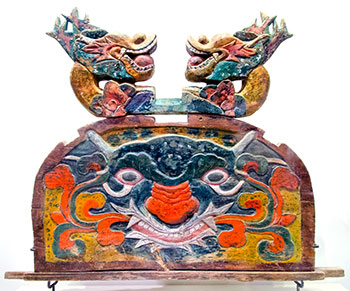
To be on the safe side, the guides, caretakers and entertainers were joined by some dragons and goblins to protect the soul and keep the evil spirits away.
The funeral bier, or sangyeo, which carried the coffin, was intricately carved and brightly painted, and was transported in a procession to the gravesite by 24 men, singing and stepping in unison to a drumbeat. A separate box or small bier carried the deceased’s spirit, so that when the large bier was burned at the end of the burial ceremony, as was the custom, the spirit would be returned to the family home and kept safely forever.
In a break with the strict rules that existed during the Joseon Dynasty regarding dress and lifestyle depending on social status, funeral biers and kokdu were one place where an elaborate display was acceptable, even for ordinary citizens. Everyone, regardless of wealth, lifestyle or popularity, was entitled to a triumphant send-off to the other world, expressed this way: “In death, we are all rich; we are all as one.”
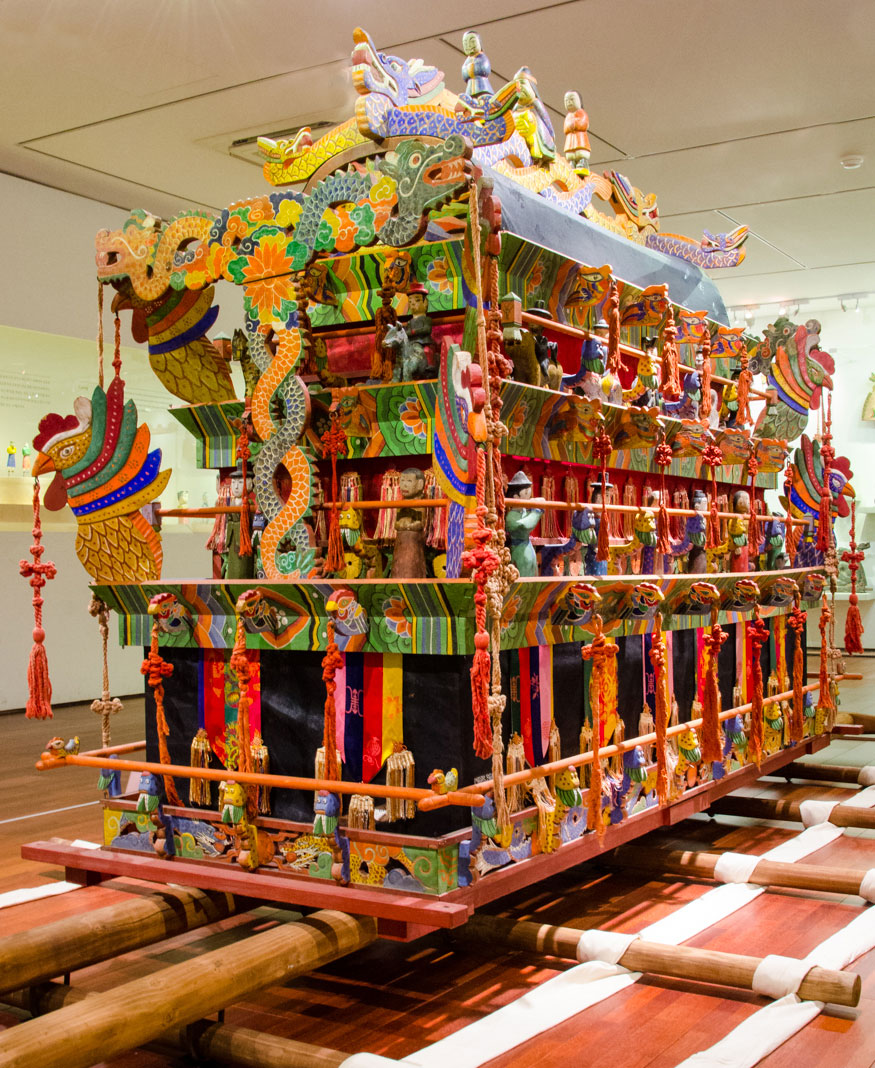
The kokdu figures were made by groups of artisans who produced the complete funeral bier together. If they received a request from another province, they would move to that area for several months to fulfill the request.
While it is still possible to occasionally witness a traditional funeral procession in remote areas of South Korea, it’s not surprising that as Korea rushes toward modernity, they represent a tradition that has largely disappeared. Fortunately, there are three museums in Seoul devoted to kokdu, where it’s easy to spend an hour or two enjoying their quirky charm. I’ve visited the first two and can highly recommend them. Party on folks!
Kokdu Museum Mokin Museum Musee Shuim
122, Dongsung-gil 83 Gyeonji-dong 36-20 Hongji-dong
Jongno-gu, Seoul Jongno-gu, Seoul Jongno-gu, Seoul
www.kokdumuseum.com www.mokinmuseum.com www.shuim.org
— Debbi

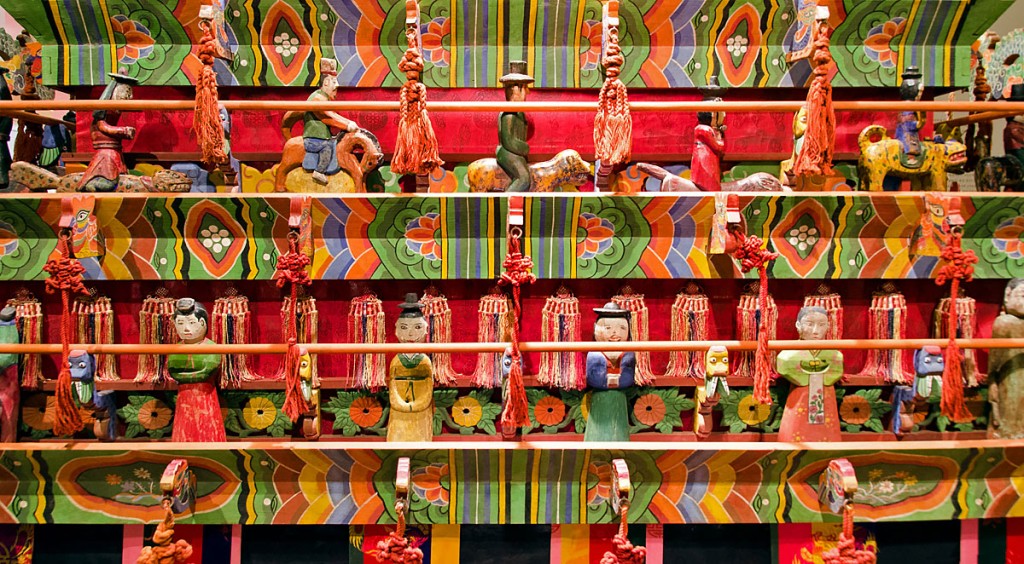
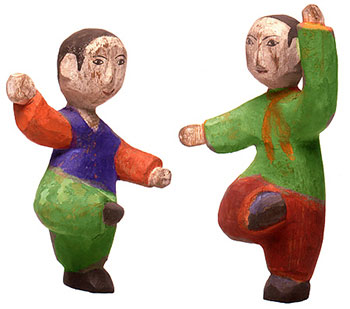
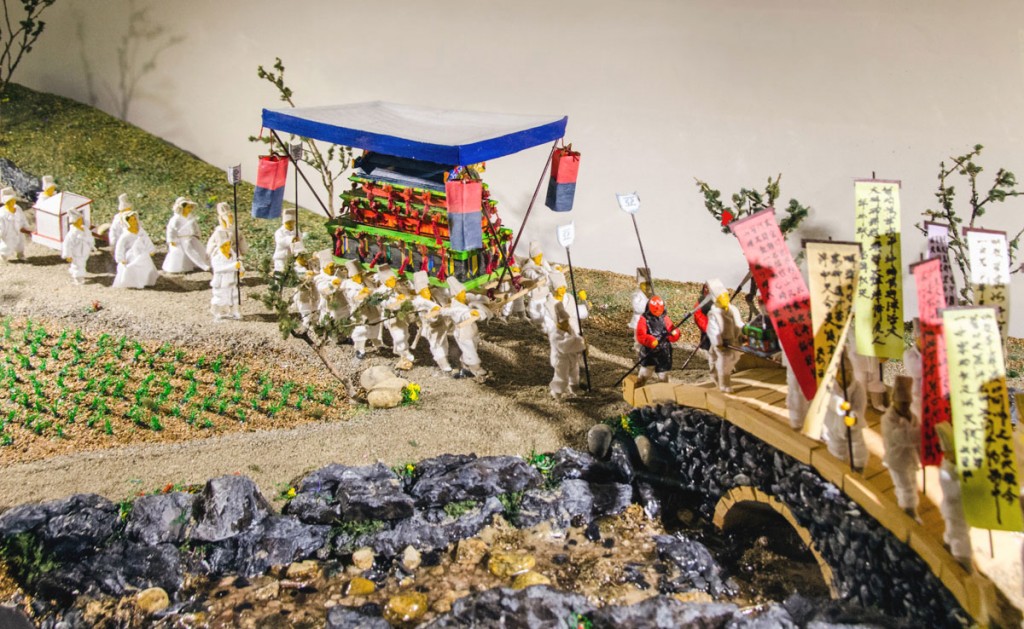
7 comments. Leave new
Such an interesting post! I can understand why you would want to take some of those figures home with you. If I am able to go back to Korea I will try to visit those museums.
I’m still on the hunt, Liz. I’m determined to collect a few of them, one way or another!
We went to the Antique Art Mall in Dapsimni today and picked one up for W25,000. The lady said he is about 100 years old.
Dapsimni is one of our favorites, Nicki! I’m planning on writing a blog about it at some point.
I have to tell you the bad news. I got fascinated, too, of Kokdu, after many Koreans swept them in the past 10 years. Lots of the fake ones are still around, and, the older folks in the antique markets tell me that they are not supposed to be sold in such perfect conditions or vivid colors. And, many of them were dipped in the antique treatment from China, North Korea and they are brought to be sold for 70-150 bucks in all over Korea.
The real ones didn’t survive another funeral (not recycled) as each household removed those and just re-used the frames of Sangyo for the one time event, and, Japanese governent forced to abandon any costly adornment but paper flowers and tassles during 1910s-1945 during their occupancy. And, these antique dealers told me they don’t believe there are so many of them all of sudden showed up. And, it is true that even Koreans do not know we had these wooden men, but, yes, I have seen the dragon heads or abstract coral shape patterns. The real stuff would not have the vivid color intact, like the museum versions. To me, they were all newly stained in the past 20-30 years, just like all palaces in Seoul. They were all newly pained in the past 20-30 years, with more colors added. And, I don’t recall Korean traditional architecture was colorful from my own younger days.
Although I was purchasing some of the Kokdu, I stopped, as I found out that there is no deep rooted story behind it once I researched further. It is like old Bronze Spoon of BC 200 old you can still find, in the market, which are smuggled, and, you are not supposed to buy something stolen.
At least, this is what I have been finding so far as of December 2018. Kokdu museum is closed, and their little version their website mentions, in Samchong-dong hanok village area is closed, at random, when the website says it is open. When you call and no one answers, it is closed. I left 1 star review for not respondingthe calls on open days.
I really advise you to get familiar with the Museum collections. And, make sure you don’t run into knockoff Kokdus Knockoffs use different colors other than 5 colors (Obang-sek) and they are larger. The Korean ones look quite flimpsy, and they tend to be more authentic. More whimsical means modern creation with modern minds.
Many Dapsimri (orange building) ground floor shop owners are jokes, to me. especially this older woman with the contemporary art, with acrylic painting-she has lots of tombstones and Jeju Harubang, but they are Chinese knockoffs. She offended me to drag me to the basement storage, filled with tones of unframed knockoff she hasn’t framed yet. I concluded that it is too strange Kokdu is all of sudden too prevalent in the market, when I haven’t seen a single one 20 years ago. Never heard of it. So, be cautious. I have a couple of ones, but, the seller clearly told me of its origin, from North Korea. via China. Nowadays, Chinese knockoff goes back to North Korea and processed and now shipped back out to South Korea with the cheated origin of North Korea of decades old.
Luckily, mine was authentic, as I found the identical style from Kyongki area, in a house museum who got the same, donated 40 years ago to their collection.
Mokin gallery in Insadong is closed when I visited the Insadong area in December, 2018, too. And, I think they will be re-open in far out in north outskirt of Old Seoul. It is getting harder to find what is authentic historical time pieces wherever I go
Thank you for all of the good information! None of it surprises me. We, too, became very suspicious when kokdu, which we had never seen before, all of a sudden started appearing everywhere. And interestingly, many of them looked the same. So we were sure they were reproductions. I don’t have a problem with reproductions, as long as they are sold as such. I have checked on the three museums I mention in my blog. According to their websites, the Kokdu Museum is closed temporarily while they prepare for the opening of two new exhibits, and the Mokin Museum in Insadong will reopen in April 2019 under a new name, “Mokin Museum Mok Seok Won” in Baumdong, Jongno-gu. And as far as I can tell, Musee Shuim is still open. I hope this helps.
Thank you again for your very interesting comments on one of my favorite examples of Korean folk art!
~ Debbi
Dear Debbi,
H L is right. Most of them are reproduction. However, it is not true that they cannot be in perfect condition or vivid color. In fact, only some of them were made in Joseon Dynasty. Others were made in early or mid 20th centuries. A Korean war veteran brought 1000 pieces of Korean folk art in early 1950s and passed away several years ago. Surprisingly, his grandchildren found this collection after his death. I have never seen anything like that. It even has all transaction records in 1950s and even price tag for each piece (like $5.50 in 1954). Obviously, the person tried to sell this in the U.S. Unfortunately an antique dealer residing in CA took most of it and I was able to get only about 200 items of them. I also gave a lot of them to my friends as an gift and currently have a few dozen of them. I can share pictures of them if you are interested in. It is just incredible to see this.